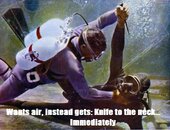Discussing the 100 ft cesa makes a little more sense in this thread. Talk me through it, what's going on in your mind? How hard are you kicking, how fast are you exhaling, etc. What tells you in your internal clock that everything is ok or not ok? And doing this with another person attached to you seems insane

.
(I am not sure what clock you are referring to, but other than that...)
The only reason I mentioned it in the other thread is because you mentioned it. It's entirely possible, but mentally tough, to exhale continuously for four minutes. Just like free-diving to any significant depth (70-100 ft/21-30m), the main skill is in the doing, to prove to oneself it is possible.
When practicing deep CESAs, the main thing is taking advantage of the fact it is just practice, so reg in, take your time, don't blow your ascent rate, use humming to control exhalation. The first few times through one is just breaking through the mental barrier of being able to continuously exhale for as long as it takes and not blow the ascent rate, and also playing with the rate of hum needed to make sure the air in the lungs will allow. Humming is about the best way to keep the airway open and not be immediately out of air in the lungs.
Also, for a variety of reasons, it is probably best to just do from a deep spot to safety stop depth:
1. Many (and in my case all) deep dives have a hang tank and reg at the safety stop, so that is as far as one needs to get.
2. Being able to hit the safety stop hang reg keeps one focused on what should be the goal if (god forbid) the deep CESA ever becomes necessary. It also reminds one that control is of the essence, including buoyancy control.
3. Deco related factors since multiple ascents are just not a good idea deco wise. At least stopping at safety stop depth is not going to take one to 1 ATM.
As far as when it really happens, well I kind of think it is a working guides job to ensure safety, even when the person is not directly under my control. Not everyone thinks that, but thankfully most people who think that way are not working as dive guides for a living (or at least won't be for long). Those of us who do this full time fully expect that if someone suffers a serious accident in our vicinity, we will very likely lose our ability to work, so we do everything to make sure accidents don't happen, and problems get help.
I know I can do a CESA from depth, and an actual OOA diver has no ability to handle really anything. They have to be on the end of a long chain of stupid actions to get in that situation, so expecting them to do anything smart is silly. So I don't expect to be doing anything but panicking, and I count on my ability to basically handle anything underwater. Full panic, even. But once the OOA diver gets a reg in, and they are starting up, they usually calm down pretty quick. It takes a long time to get from 100 feet to the surface, and the OOA diver is usually pretty relaxed by the time we get to the safety stop hang tank, and are more than happy to switch to that reg.
---------- Post added June 10th, 2013 at 10:43 PM ----------
Not at 100 feet, but at 20 (more or less), during a Rescue class I went OOA to a student (as I was instructed to do by his instructor). The student dutifully donated his primary (which was on a VERY short hose) and reached for his Air2 and put his snorkel into his mouth! He, as he had been taught, had reached over and grabbed my shoulder strap so we were now "belly to belly" but he still didn't have a reg in his mouth. He reached again for his Air2 and again put his snorkel into his mouth.
This time he grabbed the reg out of MY mouth and started using it -- BUT HE DID'T LET GO OF ME. My primary was down between us, free flowing, and he held me so tight that I couldn't get my bungeed backup into my mouth.
The ONLY good thing was that he had so lost buoyancy control was that we finally hit the surface and he let go of me. I didn't have to resort to force to separate us but I still wonder what I would have done had we gone DOWN instead of UP.
Moral of the story -- if the person is big enough, yes you can get trapped.
I am glad that someone who has actually experienced this speaks up.
It's easy to imagine a lot of hazards do not exist. It's also foolish to imagine those hazards do not exist when in charge of other people's safety.
No one ever lost betting on people (on the whole) acting stupid in a stressed situation. And betting that an OOA diver will be patiently waiting for things to arrange themselves like they are in the skill practice in the pool is similarly a losing bet.
People who have never experienced entanglement underwater just think it does not exist. And practicing S-Drills and what not in completely artificial circumstances is just missing the point. For almost everyone who is not a working guide, the first reaction to an unexpected OOA signal is checking the signaling diver's gauge. The second common reaction is to return the OOA signal. The number of divers who anything smart when confronted with an diver signalling OOA is pretty small, which is why guides get to deal with the OOA diver.




